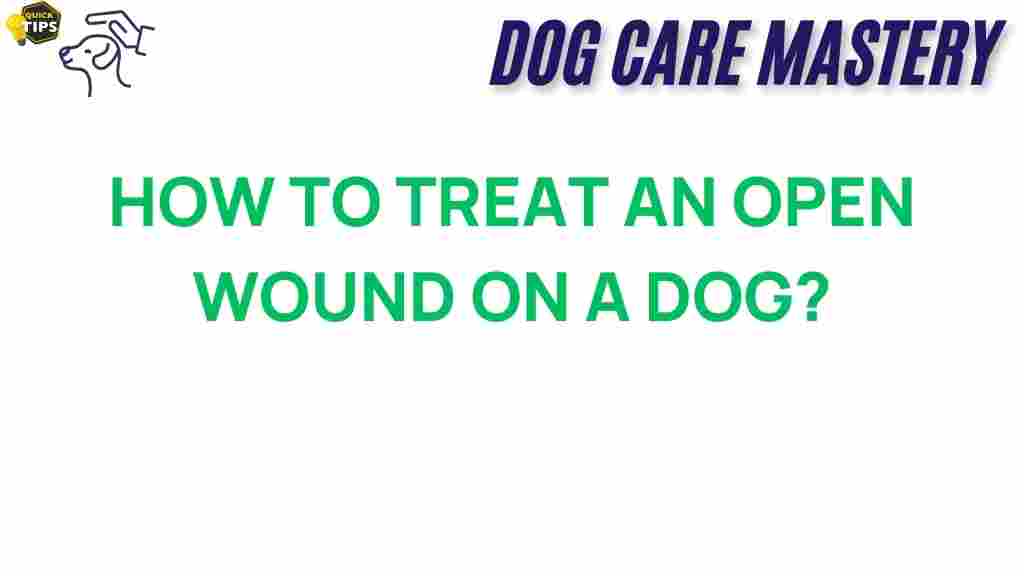Dog First Aid: Mastering the Art of Canine First Aid
Dogs are beloved companions, and their health and well-being are of utmost importance to any pet owner. Understanding the basics of dog first aid can be invaluable, especially in emergency situations. One common issue that many dog owners may encounter is treating open wounds. This article will guide you through the essential steps to effectively manage open wounds on dogs, ensuring that your furry friend receives the best care possible.
Why Understanding Dog First Aid is Important
Accidents happen, and knowing how to respond can make the difference between a minor injury and a severe health crisis. Open wounds can occur due to various reasons, including:
- Dog fights
- Accidental cuts from sharp objects
- Scratches from branches or other animals
- Insect bites or stings
Being equipped with the knowledge of dog first aid helps you act swiftly and appropriately, reducing the risk of infection and promoting faster healing.
Essential Supplies for Dog First Aid
Before diving into the treatment process, it’s crucial to have a well-stocked first aid kit specifically for your dog. Here are the essentials you should include:
- Antiseptic solution (e.g., iodine or hydrogen peroxide)
- Sterile gauze pads
- Adhesive tape
- Scissors
- Tweezers
- Non-stick bandages
- Disposable gloves
- Cold pack or ice pack
- Hydrocortisone cream (for insect bites)
Having these items on hand can facilitate quick and effective treatment in case an injury occurs.
Step-by-Step Process for Treating Open Wounds on Dogs
When your dog suffers an open wound, follow these steps to administer dog first aid effectively:
Step 1: Assess the Situation
Before treating your dog, assess the severity of the wound:
- Is it bleeding heavily?
- Is your dog in significant pain?
- Are there any foreign objects lodged in the wound?
- Is the wound deep or large?
If the wound is severe (e.g., deep lacerations, heavy bleeding), it’s essential to take your dog to a veterinarian immediately. For minor wounds, proceed with the following steps.
Step 2: Control the Bleeding
If the wound is bleeding, your first priority is to control the bleeding:
- Apply gentle pressure using a clean cloth or sterile gauze.
- If the bleeding doesn’t stop after a few minutes, apply a second layer of gauze without removing the first.
- Keep your dog calm to help reduce blood flow to the area.
Step 3: Clean the Wound
Once the bleeding is under control, it’s time to clean the wound:
- Put on disposable gloves to avoid contamination.
- Using a saline solution or antiseptic, gently clean the area around the wound.
- Do not use hydrogen peroxide directly on the wound, as it can damage the tissue.
Step 4: Apply a Dressing
After cleaning, it’s important to cover the wound:
- Use a sterile gauze pad to cover the wound.
- Secure it in place with adhesive tape or a non-stick bandage.
- Make sure it’s snug but not too tight to restrict blood flow.
Step 5: Monitor for Infection
After applying the dressing, keep an eye on the wound for signs of infection:
- Redness or swelling
- Pus or discharge
- Increased pain or tenderness
- Fever or lethargy
If you notice any of these signs, consult your veterinarian promptly.
Step 6: Follow Up Care
After initial treatment, proper follow-up care is crucial:
- Change the dressing daily or as needed.
- Keep the wound clean and dry.
- Limit your dog’s activity to prevent reopening the wound.
Ensure your dog does not lick or chew the wound, as this can introduce bacteria. You may need to use an Elizabethan collar (cone) to prevent this behavior.
Troubleshooting Common Issues in Dog First Aid
Even with the best intentions, complications can arise. Here are some common issues and how to address them:
What if the Bleeding Doesn’t Stop?
If bleeding persists after applying pressure for 10 minutes, it’s crucial to:
- Apply a clean cloth directly over the wound and continue applying pressure.
- Elevate the affected limb if possible.
- Seek veterinary care immediately.
How to Handle a Dog that is Anxious or Aggressive?
Injured dogs may act unpredictably. If your dog is anxious or aggressive:
- Enlist the help of a friend or family member to hold the dog gently.
- Use verbal soothing and calming techniques.
- If possible, wrap your dog in a towel to restrict movement and reduce stress.
When Should You Seek Professional Help?
There are situations where seeking veterinary assistance is necessary:
- The wound is deep or large.
- There is excessive bleeding that doesn’t stop.
- The wound is caused by a bite from another animal.
- Your dog shows signs of shock (e.g., pale gums, rapid breathing).
In these cases, it’s better to err on the side of caution and consult with a veterinarian.
Conclusion: Be Prepared with Dog First Aid Knowledge
Learning how to handle open wounds on your dog is an essential part of being a responsible pet owner. By mastering the art of dog first aid, you ensure that you are prepared for emergencies and can provide immediate assistance when your dog needs it most. Always keep your first aid kit stocked and familiarize yourself with the steps outlined in this guide. Remember, while your knowledge is valuable, it’s crucial to know when to seek professional help.
For more information on canine health and safety, check out this comprehensive guide. And remember to continually educate yourself on pet first aid; it could save your dog’s life one day.
By being prepared and informed, you can help ensure that your pet stays healthy and happy for years to come.
This article is in the category Health and created by dogcaremastery Team
